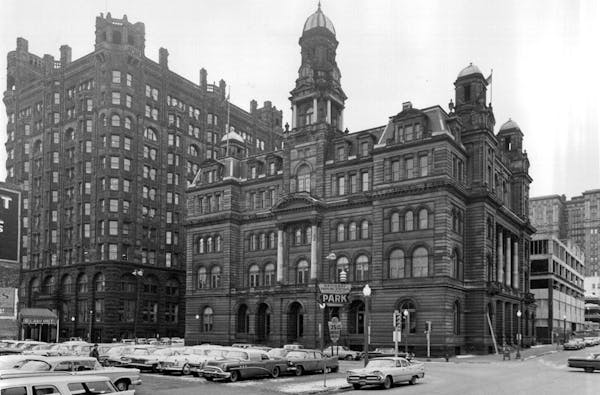Minnesota's temperature extremes are hard on sidewalk paving and street trees. But our streetscapes don't have to be so hard on us, especially during the cold and rainy days of spring and fall. There are plenty of lighting techniques that can bring life to cities.
In a city, light should originate from many levels, from on high (as in the neon sign atop the First National Bank building in St. Paul), from pedestrian-level streetlamps as well as from store windows and lobbies. Light from such varied heights brings a sense of human scale and intimacy to an urban environment.
If you look at older photos of cities at night, you'll usually find a rich array of light sources — vertical neon signs, globe-shaped streetlamps, light streaming from upper-story offices — all of which harmonize with the flow of pedestrians. But it seems that we've forgotten such nuances of urban lighting and how much it matters in a four-season climate like ours.
The latest update of the Nicollet Mall is one example. The mall now has long stretches of sidewalk that seem devoid of trees, color or even seasonal pots to make the walkways more welcoming. There's also little in the way of lighting at ground level, such as up-lit building facades or illuminated store signs.
The original mall also boasted beautiful paired streetlamps lit with glowing, incandescent bulbs. In the mornings and at dusk, they shone warmly on the steam rising from the heated sidewalks. Those streetlamps and heated sidewalks used a lot of energy and proved challenging to maintain.
There are, however, durable and sustainable lighting technologies that allow us to add a bit of light to a city at night.
Take the recently renovated Schmidt Brewery in St. Paul, which is now known as the Schmidt Artist Lofts. The lighting there was designed to accentuate the brewery's crenelated tower and cornice details. BKV Group and Pfister Associates also up-lit the smokestack so that the inset logo — SCHMIDT's — is visible from blocks away. The landmark red neon Schmidt sign atop the brewery is once again a beacon on W. 7th Street, as it has been for a century.
Then there's the Pillsbury "A" Mill. Lighting consultants Schuler Shook joined forces with BKV Group and Pfister to install angled up-lighting that celebrates the texture and depth of the 138-year-old limestone walls, a characteristic generally lost at night. On the roof, they introduced bursts of color by lighting the water tower. Visible from the 3rd Avenue Bridge, the water tower's warm white and blue colors complement the historic neon Pillsbury sign nearby.
Creating transparency
While buildings' walls make great surfaces for lighting, we sometimes need to see into a building — through windows and lobby doors. Being able to get a glimpse inside a building adds a sense of depth and movement as we walk along the street at night.
"We try to design storefronts and buildings where the light from inside can leak out," said Brady Halverson, director of landscape architecture with the BKV Group. "Transparent storefronts and pools of light at doorways help to create a sense of arrival."
Variety and temperature
Good architectural lighting can highlight more than textures and rooftops. It also takes color tones and the direction of light into consideration.
Architect Peter Pfister of Pfister Associates, explained: "When you install a lamp at the middle of your living room ceiling, you get a blanket of light without highlights or darker spots. But if you light the room with table lamps and focused spotlights, you get more varied and inviting spaces layers of light," he said.
That's what good urban lighting can do.
Beyond the sources of light, Pfister explained that the "temperature" of light "affects the mood of a street."
Measured in Kelvin degrees, lighting temperature doesn't gauge how hot or bright a light source seems, but its place along the color spectrum.
For example, the wall lighting at the "A" Mill and Schmidt Brewery ranges from 2,600 to 3,000 K. degrees, creating warmer yellows.
Many parking lot lights and streetlamps are calibrated at higher temperatures (4,000 to 5,000 K.), which cast much colder, stark light that reaches into the blue end of the color spectrum.
It's often assumed that such light is essential for safety. But lighting designers are using warmer light tones to provide security and warmth, just as they're using strategically poised spotlights to highlight the texture of building walls — and how glowing colors create a rainy nighttime atmosphere meant to be experienced and not just endured.
Frank Edgerton Martin is a consulting writer for architecture and design firms and a historic landscape preservation planner.
![The Basilica of St. Mary is pictured at sunset Wednesday, Jan. 14, 2015 in Minneapolis. ] (Aaron Lavinsky | StarTribune)](https://arc.stimg.co/startribunemedia/XVZ5DBLZAMSVD5HSRTM6DCBDNE.jpg?fit=crop&crop=faces&w=550&&auto=format)





